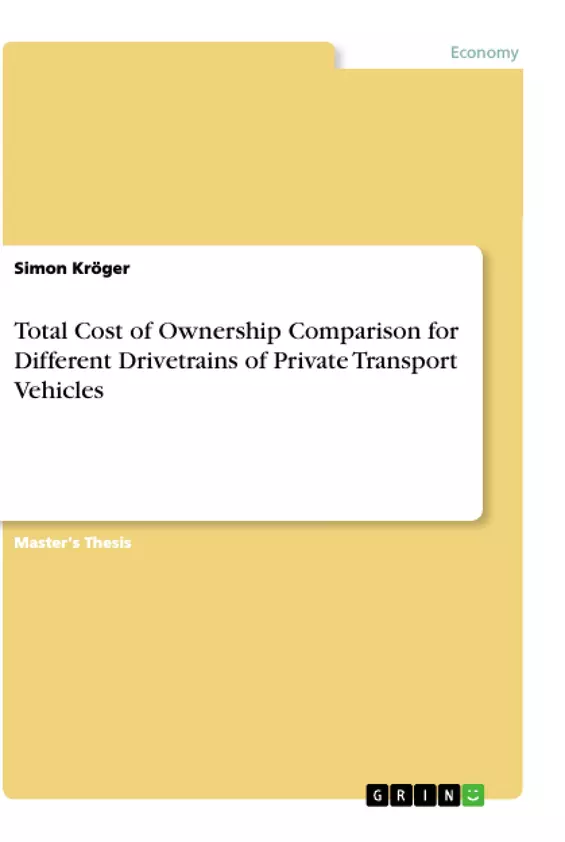Transportation is the source of 25% of the EU-27 greenhouse gas emissions. Specifically, cars are responsible for around 12% of the EU-27 emissions of carbon. Additionally, emissions from the transport sector have increased continuously since 2014. Therefore, the reduction of emissions from the transport sector is an integral element of the EU climate and energy policy to comply with the Paris Agreement.
The electrification of the transport sector offers the opportunity to utilize the increasing share of renewable energy generation. Thus, scholars believe that electric vehicles, such as battery electric vehicles (BEVs), plug-in hybrid electric vehicles (PHEVs), hybrid electric vehicles (HEVs), and fuel cell electric vehicles (FCEVs), have the potential to lower emissions and contribute to the transformation of the mobility sector.
However, the breakthrough of electric vehicles still faces several barriers. Perhaps the most significant barrier appears to be the public's general consensus that electric drivetrains are more expensive than conventional drives. However, the literature suggests that electric vehicles might already be more cost-efficient than comparable conventional drives. Yet, the cost-benefits are mostly non-transparent to consumers as they put too much weight on the high initial investment costs compared to conventional internal combustion engine vehicles (ICEVs) and underestimate the cost savings through lower operating costs. In order to overcome this misjudgment and to help consumers make more profound purchasing decisions, the literature suggests the total cost of ownership (TCO) approach, which includes both investment and operating costs over the ownership period.
This study aims to compare the consumer-oriented TCO for different drivetrains of private transport vehicles in Germany. Although the transportation sector emits 19% of Germany’s greenhouse gases, electric vehicles only account for 17% of the newly registered vehicles in the first half of 2020. As a result, the German government approved an increase in subsidies for the purchase of electric vehicles in June 2020 to promote the attractiveness of more environmentally friendly vehicles. Against that background, this study investigates whether conventional drives still exhibit a financial advantage over electric vehicles. For that purpose, this study compares the TCO of BEVs, PHEVs, HEVs, FCEVs as well as petrol and diesel ICEVs.
Inhaltsverzeichnis (Table of Contents)
- Introduction
- Literature Review
- Drivetrains of Private Transport Vehicles
- Total Cost of Ownership
- One-time Costs
- Investment Costs
- Battery Replacement Costs
- Resale Value
- Annual Operating Costs
- Energy Consumption Costs
- Inconvenience Costs
- Other Operating costs
- Design of Total Cost of Ownership Analysis
- Model and Data
- TCO Model
- Vehicle Sample
- Driver Profile
- One-time Costs
- Investment Costs
- Battery Replacement Costs
- Resale Value
- Annual Operating Costs
- Energy Consumption Costs
- Inconvenience Costs
- Other Operating Costs
- Model and Data
- Total Cost of Ownership Estimates
- Base Case Scenario
- Sensitivity Analysis
- Driver Profile
- Investment Costs
- Resale Value
- Energy Consumption Costs
- Inconvenience Costs
- Discount Rate
- Conclusion
Zielsetzung und Themenschwerpunkte (Objectives and Key Themes)
This thesis aims to provide a comprehensive analysis of the total cost of ownership (TCO) for different drivetrains of private transport vehicles. The study focuses on identifying key cost drivers and analyzing their impact on TCO over a defined period of time.
- Comparison of TCO for various drivetrains, including internal combustion engine (ICE), electric vehicles (EVs), and hybrid vehicles (HEVs).
- Assessment of the influence of various cost components, such as investment costs, energy consumption, and operating expenses, on TCO.
- Analysis of sensitivity to key parameters, including driver profile, government subsidies, and resale value.
- Development of a TCO model to facilitate the evaluation and comparison of different drivetrain options for private transport vehicles.
- Evaluation of the economic viability of alternative drivetrains in the context of evolving automotive technology and market trends.
Zusammenfassung der Kapitel (Chapter Summaries)
- Chapter 1: Introduction - Provides an overview of the research topic, emphasizing the importance of analyzing TCO for different drivetrains of private transport vehicles. It outlines the study's objectives and the structure of the thesis.
- Chapter 2: Literature Review - Explores existing research on drivetrain technologies, TCO analysis, and related cost components. It discusses various factors influencing TCO, including investment costs, energy consumption, and resale value.
- Chapter 3: Design of Total Cost of Ownership Analysis - Presents the methodology employed in the TCO analysis. This chapter describes the TCO model, the vehicle sample, and the driver profile used in the study. It also details the data collection process and the calculation of one-time and annual operating costs.
- Chapter 4: Total Cost of Ownership Estimates - Provides TCO estimates for the selected vehicles based on the established model and data. This chapter presents the results of the base case scenario analysis and analyzes the sensitivity of TCO to various parameters, including driver profile, investment costs, resale value, energy consumption costs, and the discount rate.
Schlüsselwörter (Keywords)
The primary keywords and focus topics of this thesis are: Total Cost of Ownership, Drivetrain Technologies, Electric Vehicles, Internal Combustion Engines, Hybrid Vehicles, Investment Costs, Energy Consumption, Resale Value, Sensitivity Analysis, and Economic Viability.
- Quote paper
- Simon Kröger (Author), 2020, Total Cost of Ownership Comparison for Different Drivetrains of Private Transport Vehicles, Munich, GRIN Verlag, https://www.grin.com/document/993819



